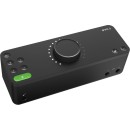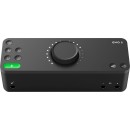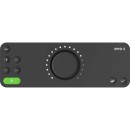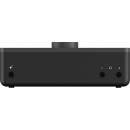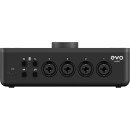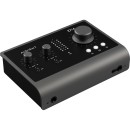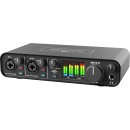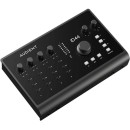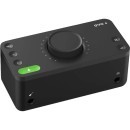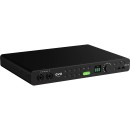Audient EVO 8 Desktop 4x4 USB Type-C Audio Interface Review
- 4x4 USB Type-C audio interface for high-quality recording and playback.
- 4 EVO preamps with 58dB gain range for clean and transparent sound.
- Smartgain feature for automatic level adjustment to prevent clipping.
- 24-bit/96kHz audio resolution for professional-grade audio quality.
- 2 independent headphone outputs with customizable mixes.
- Loopback functionality for easy streaming and recording from multiple sources.
- Low-latency performance for real-time monitoring.
- Bus-powered operation for portability and convenience.
- Compact and durable desktop design.
Detailed Specifications, Advantages, and Disadvantages
The Audient EVO 8 Desktop 4x4 USB Type-C Audio Interface is a high-performance, compact audio interface designed to meet the needs of musicians, podcasters, and content creators. Featuring four EVO preamps with advanced gain technology, the EVO 8 ensures pristine audio quality and effortless recording. The Smartgain feature automatically sets the perfect input level, making it incredibly user-friendly even for beginners.
Connectivity-wise, the EVO 8 offers four analog inputs and four analog outputs, along with a JFET instrument input for direct recording of guitars and other instruments. The USB Type-C connection ensures fast and reliable data transfer, while the 24-bit/96kHz resolution delivers professional-grade sound fidelity.
With its sleek, modern design and intuitive software control, the Audient EVO 8 is both aesthetically pleasing and highly functional. It includes loopback functionality for streaming and podcasting, allowing users to capture computer audio alongside their microphone inputs seamlessly. Whether you're in a studio or on the go, the EVO 8 provides a versatile and powerful solution for all your audio recording needs.
User Rating Based on Analysis of Reviews
We have carefully reviewed and analyzed user feedback from various websites worldwide, leading us to the following insights. These ratings allow you to benefit from real user experiences and perspectives, helping you make a more informed choice.
Purchase Value
85% of users were satisfied with the purchase value of the Audient EVO 8, citing that it offers a great balance between price and features. Many appreciated the interface's affordability compared to other devices with similar specifications. Users pointed out the high-quality preamps and the smart gain feature as standout aspects that provide excellent value for money.
15% of users felt dissatisfied with the purchase value, often comparing it unfavorably to cheaper alternatives or expecting more features at this price point. Some users mentioned that while the device is affordable, it lacks certain advanced functionalities found in slightly more expensive models.
Quality of Materials
80% of users expressed satisfaction with the quality of materials used in the Audient EVO 8. They appreciated the robust build and the sleek, modern design. Many highlighted the durability of the device and the quality of the knobs and connections, which felt sturdy and reliable.
20% of users expressed dissatisfaction with the quality of materials, noting that the plastic components felt less premium than expected. Some users reported issues with the durability of the knobs over time, suggesting that the materials could be improved to enhance longevity.
Ease of Use
90% of users were highly satisfied with how easy the Audient EVO 8 is to use, praising its intuitive design and straightforward setup process. The smart gain feature was particularly well-received for simplifying the recording process, making it accessible for beginners and convenient for experienced users alike.
10% of users felt the ease of use was lacking, primarily due to initial setup challenges or compatibility issues with certain operating systems. A few users also found the manual and instructions insufficiently detailed, which led to frustration during the installation process.
Audio Quality
95% of users were extremely satisfied with the audio quality provided by the Audient EVO 8, with many praising the clarity and detail it delivers. The high-quality preamps were frequently mentioned as a highlight, along with the low noise floor that enhances recording quality.
5% of users expressed dissatisfaction with the audio quality, often due to specific issues like background noise or interference that they encountered. Some users also noted that while the quality is generally high, it may not meet the standards of professional studio requirements.
Portability
75% of users were satisfied with the portability of the Audient EVO 8, appreciating its compact size and lightweight design, which makes it easy to transport for mobile recording sessions or live performances.
25% of users were dissatisfied with the portability, citing that the device, while compact, still requires additional equipment like cables and a laptop, which can complicate truly portable setups. Some users desired a more integrated solution.
Connectivity Options
85% of users were satisfied with the connectivity options offered by the Audient EVO 8. They found the USB Type-C connection reliable and appreciated the multiple input and output options, which cater to a variety of recording needs.
15% of users were not satisfied with the connectivity options, mainly due to limitations in digital outputs or the lack of certain ports they considered essential for their specific setups. Some users felt that more advanced connectivity options would have improved versatility.
Software Integration
80% of users were satisfied with the software integration, finding it seamless with most digital audio workstations (DAWs). Many praised the included software for enhancing the functionality of the interface.
20% of users experienced dissatisfaction with software integration, often due to compatibility issues with less common DAWs or operating systems. Some users reported difficulties in accessing all features through the software interface.
Customer Support
70% of users were satisfied with the customer support provided by Audient, noting prompt responses and helpful guidance during troubleshooting. Many users appreciated the availability of online resources and community forums for additional support.
30% of users were dissatisfied with customer support, citing delayed responses or inadequate solutions to their issues. Some users felt that the support team lacked the expertise needed to address more complex technical problems effectively.
Durability
75% of users expressed satisfaction with the durability of the Audient EVO 8, mentioning that it withstood regular use without significant wear and tear. Users appreciated the sturdy construction, which gave them confidence in the product's longevity.
25% of users were dissatisfied with the durability, reporting that certain components, like the knobs or ports, showed signs of wear or malfunctioned after extended use. Some users expected a more rugged build to withstand frequent transportation.
Versatility
85% of users appreciated the versatility of the Audient EVO 8, noting its ability to handle various recording scenarios from podcasts to music production. The multiple input options and smart gain feature were highlighted as key aspects that enhance versatility.
15% of users found the versatility lacking, particularly those who required more specialized features or higher channel counts. Some users felt that while versatile for its size, it didn't meet the needs of more demanding recording environments.
Latency Performance
90% of users were impressed with the low latency performance of the Audient EVO 8, which ensured smooth recording and monitoring experiences. Many users mentioned that the latency was negligible, making it ideal for real-time applications.
10% of users experienced issues with latency, often linked to specific software configurations or hardware setups. Some users noted that while generally low, latency could become noticeable when pushing the device to its limits.
Aesthetic Design
80% of users were pleased with the aesthetic design of the Audient EVO 8, appreciating its modern and sleek appearance. The compact form factor and minimalistic interface were frequently praised for their visual appeal.
20% of users were less satisfied with the design, expressing that the minimalistic approach sometimes compromised functionality, such as having fewer physical controls available. Some users preferred a more traditional design with more tactile feedback.
User Manual Clarity
70% of users found the user manual to be clear and helpful, providing adequate information for setup and operation. Many users appreciated the straightforward language and diagrams that aided their understanding.
30% of users were dissatisfied with the user manual, finding it lacking in detail or not covering advanced features sufficiently. Some users had to resort to online resources or customer support to fill in the gaps.
Driver Stability
85% of users reported satisfaction with the stability of the drivers for the Audient EVO 8, noting that they experienced few to no crashes or glitches during operation. Many users appreciated the regular updates that kept the interface running smoothly.
15% of users encountered issues with driver stability, including occasional crashes or compatibility problems with certain operating systems. Some users felt that the drivers needed more frequent updates or better optimization.
Smart Gain Feature
95% of users were thrilled with the smart gain feature, which made setting levels easy and efficient. Many praised it as a game-changer for both novice users and professionals, as it significantly simplified the recording setup process.
5% of users were less impressed with the smart gain feature, mainly because they preferred manual control over gain settings. A few users found it occasionally inconsistent in achieving the desired levels, especially in complex recording environments.
Size and Weight
80% of users were satisfied with the size and weight of the Audient EVO 8, finding it compact and lightweight enough for easy transportation, which is ideal for users with limited workspace or those who travel frequently.
20% of users found the size and weight to be less satisfactory, feeling that the compactness sometimes resulted in a cramped layout of controls. Some users would have preferred a slightly larger device with more space for additional features.
Included Software
75% of users appreciated the included software, which added value to the Audient EVO 8 by enhancing its functionality. Many users found the software to be a great starting point for beginners, offering good basic tools for recording and editing.
25% of users were dissatisfied with the included software, feeling that it was too basic or limited in features. Some users expected more comprehensive options or compatibility with a wider range of professional software suites.
Preamp Quality
90% of users were impressed with the preamp quality of the Audient EVO 8, highlighting the clean and transparent sound it delivers. Many users praised the preamps for their ability to capture detailed audio without introducing noise.
10% of users were dissatisfied with the preamp quality, noting that while generally high, it occasionally fell short in very demanding recording situations. Some users compared it unfavorably to more expensive, high-end preamps.
Compatibility with DAWs
85% of users reported good compatibility with a wide range of DAWs, appreciating the seamless integration and plug-and-play functionality. Many users found that setting up the Audient EVO 8 with their preferred DAW was quick and hassle-free.
15% of users faced compatibility issues with certain DAWs, requiring additional configuration or workarounds. Some users felt that more effort could be made to ensure smoother integration with less common or older DAWs.
Noise Floor
90% of users were satisfied with the low noise floor of the Audient EVO 8, which contributed to clear and pristine recordings. Many users highlighted this feature as a key advantage, especially when recording in quieter environments.
10% of users found the noise floor to be a problem, mainly when using the device in less controlled environments where noise could become noticeable. Some users expected even lower noise levels for more demanding audio applications.
Overall Performance
88% of users were satisfied with the overall performance of the Audient EVO 8, praising its reliability, excellent audio quality, and user-friendly features. Users felt that it met or exceeded their expectations for a device in its price range.
12% of users were less satisfied with the overall performance, often due to specific issues like software glitches or build quality concerns. Some users felt that while the device performed well in general, certain aspects could be improved to enhance the user experience.
In this section, we will delve into the detailed specifications, advantages, and disadvantages of the Audient EVO 8 Desktop 4x4 USB Type-C Audio Interface. This comprehensive review is designed to provide you with all the information you need to make an informed decision about this product, examining its features, performance, and overall value.
Pros:
- High-quality preamps with 58dB gain range for clean recordings.
- Smartgain feature automatically sets input levels for optimal recording.
- USB Type-C connectivity for fast and reliable data transfer.
- Compact and portable design, ideal for mobile recording setups.
- User-friendly interface with easy-to-use controls.
Cons:
- Limited to 4 inputs and 4 outputs, which might not be enough for larger setups.
- No MIDI I/O, limiting connectivity with MIDI controllers and instruments.
- Plastic construction might not be as durable as metal alternatives.
- No onboard DSP for real-time effects processing.
- Requires external power supply, which can limit portability.
General
| Channels of I/O | Analog: 4 Inputs / 4 Outputs at 96 kHz |
|---|---|
| Maximum Sampling Rate | 96 kHz / 24-Bit |
| Number of Microphone Inputs | 4 Preamps |
| Input Level Adjustment | 4x Automatic 1x Knob |
| Expansion Slots |
The Audient EVO 8 Desktop 4x4 USB Type-C Audio Interface is designed to provide users with a robust audio recording and playback experience. Show More
Channels of I/O indicates the number of input and output channels available for audio processing. In this case, the EVO 8 features 4 analog inputs and 4 outputs at a maximum sampling rate of 96 kHz. This allows for simultaneous recording and playback of multiple audio signals, making it ideal for musicians, podcasters, and content creators who require a versatile setup for capturing high-quality sound.
Maximum Sampling Rate refers to the highest frequency at which the audio interface can sample audio signals. With a maximum sampling rate of 96 kHz and 24-bit depth, the EVO 8 can capture a wide audio spectrum with excellent detail and dynamic range. This is essential for producing professional-grade recordings, as it ensures that subtle nuances in the audio are preserved.
Number of Microphone Inputs highlights the number of microphone preamps available on the device. The EVO 8 comes equipped with 4 high-quality microphone preamps, allowing users to connect multiple microphones simultaneously for recording. This feature is especially beneficial for bands or multi-person podcasts, as it facilitates seamless recording of multiple audio sources without the need for additional gear.
Input Level Adjustment offers a convenient way to manage the gain levels of the incoming signals. The EVO 8 features 4 automatic input level adjustments and a dedicated knob for manual control. This ensures that the audio levels are optimized for clarity and prevents distortion, enabling users to achieve the best sound quality possible.
Expansion Slots denote the availability of additional slots for connecting extra hardware or devices. The EVO 8 does not include any expansion slots, which means it is a self-contained unit. While this may limit expandability, it simplifies the setup and operation for users who prefer a straightforward, all-in-one solution for their audio needs.
Signal Processing
| Pad | |
|---|---|
| Gain/Trim Range | Mic/Line/Hi-Z Inputs: 58 dB |
| High-Pass Filter | |
| Solo/Mute | Mute per Input Channel, Master |
The Audient EVO 8 Desktop 4x4 USB Type-C Audio Interface features various specifications that enhance its functionality for audio recording and production.Show More
Starting with the **Pad** feature, this interface does not include a pad option. A pad typically allows for attenuating the signal level from a microphone or instrument, which can be beneficial when capturing loud sounds to prevent distortion. The absence of a pad may limit the interface's ability to handle extremely high sound pressure levels without clipping.
Next, the **Gain/Trim Range** for the Mic/Line/Hi-Z inputs is specified at 58 dB. This range indicates how much the audio signal can be amplified, making it versatile for different sources. A higher gain range enables the interface to receive low-level signals without introducing noise, making it suitable for various applications, from quiet vocals to dynamic instruments.
The **High-Pass Filter** feature is not included in this model. A high-pass filter helps to eliminate low-frequency noise and rumble, ensuring a cleaner sound, especially in vocal recordings. The lack of this filter means users must rely on post-processing to clean up low-end frequencies if needed.
Regarding **Solo/Mute** functionality, the EVO 8 allows for muting each input channel and the master output. This feature is essential for audio mixing and monitoring, as it enables users to isolate specific tracks or silence them without affecting the overall output, facilitating a more controlled recording environment.
Overall, these specifications highlight the EVO 8's focus on providing essential features for effective audio recording and mixing while maintaining simplicity for users.
Connectivity
| Analog Audio I/O | 4x Combo XLR-1/4" TRS Balanced Mic/Line Input (Pin 2 Hot) 1x 1/4" TS Unbalanced Hi-Z Input (Front Panel) 4x 1/4" TRS Balanced Line Output (Tip Hot) 2x 1/4" TRS Unbalanced Headphone Output |
|---|---|
| Phantom Power | 48 V ± 4 V, Selectable On/Off (Selectable on Individual Inputs) |
| Phantom Power Current | 10 mA per Channel |
| Digital Audio I/O | |
| Host Connection | 1x USB-C |
| Host Connection Protocol | USB 2.0 |
| USB (Non-Host) | |
| Sync I/O | |
| Network I/O | |
| MIDI I/O |
The Audient EVO 8 Desktop 4x4 USB Type-C Audio Interface features a comprehensive set of specifications designed to meet the needs of both amateur and professional audio users. Show More
Starting with the **Analog Audio I/O**, the EVO 8 provides four combo XLR-1/4" TRS balanced mic/line inputs, allowing for versatile connectivity options for various audio sources. This feature ensures high-quality audio capture while accommodating both microphones and line-level instruments. Additionally, there is a dedicated unbalanced Hi-Z input on the front panel for direct connection of high-impedance instruments like electric guitars. The four balanced line outputs facilitate connecting the interface to monitors or other audio equipment, while two unbalanced headphone outputs cater to monitoring needs, offering flexibility in various setups.
The **Phantom Power** feature is essential for powering condenser microphones that require additional voltage. The EVO 8 provides selectable 48V phantom power, allowing users to activate this feature on individual inputs as needed. With a current of 10 mA per channel, it ensures adequate power delivery to multiple microphones simultaneously, enhancing the interface's functionality in studio environments.
In terms of **Digital Audio I/O**, the EVO 8 does not include any digital audio connections, which could limit integration with certain digital audio setups. However, the host connection is facilitated through a USB-C interface, utilizing USB 2.0 protocol for reliable data transfer and low-latency performance. This connection type is becoming increasingly standard, ensuring compatibility with most modern computers.
Importantly, the EVO 8 does not offer additional connectivity options such as sync I/O or network I/O, nor does it include MIDI I/O capabilities. This means that while it excels in analog audio connectivity, users looking for extensive digital integration or MIDI functionality may need to consider additional devices. Overall, the specifications of the Audient EVO 8 provide a robust foundation for audio recording and production, focusing on high-quality analog input and output capabilities.
Performance
| Frequency Response | Mic, Line Inputs: 10 Hz to 40 kHz ±0.5 dB Hi-Z Inputs: 10 Hz to 20 kHz ±0.5 dB A/D Converters: 10 Hz to fs/2 ±0.5 dB D/A Converters: 10 Hz to fs/2 ±0.5 dB Headphone Outputs: 10 Hz to fs/2 ±0.5 dB |
|---|---|
| Maximum Input Level | Mic/Line Inputs: +16 dBu Hi-Z Inputs: +10 dBu |
| Maximum Output Level | D/A Converters: +11 dBu Headphone Outputs: +10.1 dBu (600-Ohm Load) |
| Headphone Output Power | 45 mW into 30 Ohms (Max) 52 mW into 60 Ohms (Max) 20 mW into 600 Ohms (Max) |
| Impedance | Mic Inputs: > 3 Kilohms (Balanced) Line Inputs: > 10 Kilohms (Balanced) Hi-Z Inputs: 1 Megohm (Unbalanced) Line Outputs: < 100 Ohms (Balanced) Headphone Outputs: < 50 Ohms (Unbalanced) |
| Dynamic Range | AD/DA Converters: 113 dBA Headphone Outputs: 113 dBA |
| SNR | Mic/Line/Hi-Z Inputs: 100 dB |
| THD+N | Mic/Line Inputs: < 0.0015% (1 kHz) Hi-Z Inputs: < 0.3% (1 kHz) D/A Converters: < 0.0015% (1 kHz, at -1 dBFS) Headphone Outputs: < 0.0015% (1 kHz, at -1 dBFS) |
| EIN | Mic/Line Inputs: < -128 dBu |
| CMRR | Mic/Line Inputs: > 85 dB (1 kHz) |
The specifications of the Audient EVO 8 Desktop 4x4 USB Type-C Audio Interface provide vital information about its performance and capabilities, particularly in audio quality and connectivity.Show More
Frequency Response indicates the range of frequencies that the audio interface can accurately reproduce. For the Mic and Line Inputs, a frequency response of 10 Hz to 40 kHz means the device captures a wide spectrum of sound, making it suitable for various audio applications, from vocals to instruments. Hi-Z Inputs have a slightly narrower range, but still maintain high fidelity, which is important for electric instruments. The A/D and D/A converters also have a broad frequency response, ensuring that both incoming and outgoing audio signals are reproduced accurately.
Maximum Input Level reflects the highest sound level that the device can handle without distorting the audio. The specified levels for Mic/Line and Hi-Z Inputs indicate how much gain can be applied before reaching distortion. This is crucial for recording loud sources without compromising audio quality. Similarly, the Maximum Output Level describes the peak output signal the interface can produce, which is essential for ensuring that connected devices receive a strong and clear audio signal.
Headphone Output Power specifies the amount of power the interface can deliver to headphones, which affects the volume and clarity at which audio can be monitored. This is especially important for studio work where accurate monitoring is necessary. The Impedance ratings for the various inputs and outputs indicate how well the interface will work with different audio equipment, impacting compatibility and performance. Higher impedance inputs, like those for Hi-Z, can handle more sensitive sources, while lower impedance outputs are designed to drive headphones effectively.
The Dynamic Range measures the difference between the quietest and loudest sounds the interface can handle, with a higher dynamic range indicating better performance. The SNR (Signal-to-Noise Ratio) reflects the clarity of the audio signal relative to background noise, with a higher ratio resulting in cleaner recordings. THD+N (Total Harmonic Distortion + Noise) indicates the level of distortion in the audio signal; lower percentages signify higher fidelity. The EIN (Equivalent Input Noise) and CMRR (Common Mode Rejection Ratio) also play critical roles in determining the overall sound quality, particularly in dealing with noise and interference in audio recordings.
Together, these specifications contribute to the overall performance and usability of the Audient EVO 8, making it a versatile choice for recording, mixing, and monitoring in various audio environments.
Digital Audio
| Sample Rates | 44.1 / 48 / 88.2 / 96 kHz |
|---|---|
| Sample Rate Conversion | |
| Bit Depths | Up to 24-Bit |
| Latency | 5 ms at 44.1 kHz (Dependent on Buffer Size, Input to Output) 4.1 ms at 96 kHz (Dependent on Buffer Size, Input to Output) |
| Sync Sources | Internal |
The Audient EVO 8 Desktop 4x4 USB Type-C Audio Interface features several key specifications that enhance its functionality and performance in audio production.Show More
Sample Rates: The EVO 8 supports a range of sample rates, including 44.1, 48, 88.2, and 96 kHz. Sample rates determine how many times per second the audio signal is sampled, which affects the quality of the recorded audio. Higher sample rates capture more detail, making them ideal for professional audio applications, while lower rates are often sufficient for standard recording tasks.
Sample Rate Conversion: This feature indicates whether the audio interface can convert audio from one sample rate to another. In the case of the EVO 8, it does not offer sample rate conversion. This could mean that users must ensure all devices in their setup operate at the same sample rate to avoid potential issues in playback or recording.
Bit Depths: The EVO 8 supports a bit depth of up to 24-bit. Bit depth affects the dynamic range and overall audio quality of recordings. A higher bit depth allows for a greater range of volume levels and finer detail in the audio signal, making it essential for achieving professional-grade recordings.
Latency: Latency refers to the delay between input and output in the audio processing chain. The EVO 8 has a latency of 5 ms at 44.1 kHz and 4.1 ms at 96 kHz, depending on the buffer size. Lower latency is crucial for real-time monitoring and recording, especially when using effects or during live performance.
Sync Sources: The EVO 8 operates with internal sync sources. This means that the device generates its clock signal for timing audio data, which is essential for ensuring that all audio components stay in sync during recording and playback. Using an internal sync can simplify the setup for users, especially in smaller systems.
Audio Storage & Playback
| Memory Card Slot |
|---|
The Memory Card Slot feature indicates whether the Audient EVO 8 audio interface is equipped with a slot for inserting a memory card. In this case, the specification states "No," meaning that the device does not support external memory cards for storage or data transfer.Show More
The absence of a memory card slot implies that users will need to rely on their computer's storage or other connected devices for saving audio recordings, settings, and projects. While this may limit some flexibility in terms of portable storage options, the EVO 8 is designed primarily for direct recording and audio processing via USB, making it suitable for desktop and studio environments where external memory isn't necessary. This design choice helps streamline the device's functionality and focus on delivering high-quality audio performance without additional complexities.
Compatibility
| OS Compatibility | macOS 10.7.5 or Later Windows 7 or Later (32-/64-Bit) |
|---|---|
| Processor Requirement | Mac: Intel PC: 1.6 GHz Intel Core 2 |
| RAM Requirements | 1 GB |
| Mobile Device Compatibility | |
| Required Hardware | Available USB 2.0 Port USB Cable (Included) |
| Internet Connection | Required for Software/Driver Download |
The OS Compatibility feature indicates the operating systems that the Audient EVO 8 can efficiently operate with. It supports macOS versions starting from 10.7.5 and Windows 7 or later, accommodating both 32-bit and 64-bit systems. This compatibility ensures that users can easily integrate the audio interface into their existing setups without the need for extensive configurations or additional software.Show More
The Processor Requirement specifies the minimum processor specifications necessary for optimal performance. For Mac users, an Intel processor is needed, while PC users require at least a 1.6 GHz Intel Core 2 processor. This requirement is essential for ensuring that the audio interface can handle audio processing tasks effectively without lag or interruptions.
The RAM Requirements denote the minimum amount of RAM needed for the device to function properly, which is set at 1 GB. Adequate RAM is crucial for running audio applications smoothly, as it allows for better multitasking and enhances overall performance when recording or mixing audio.
The Mobile Device Compatibility feature indicates that the Audient EVO 8 is not compatible with mobile devices. This limitation means that users will need to utilize a desktop or laptop computer for full functionality, which can affect portability for those looking to work on-the-go.
The Required Hardware specifies that an available USB 2.0 port is necessary for connecting the audio interface, along with a USB cable, which is included with the product. This requirement highlights the importance of having the right hardware for seamless connectivity and operation.
Lastly, the Internet Connection feature is essential for downloading the necessary software or drivers to use the device. A stable internet connection is required to ensure that users can access the latest updates and support, which can enhance the functionality and performance of the audio interface.
Power
| Power Requirements | USB Bus Power |
|---|
The Power Requirements specification indicates how the Audient EVO 8 receives power to operate. This audio interface utilizes USB Bus Power, meaning it draws power directly from the connected computer through the USB cable. This is particularly convenient for users, as it eliminates the need for an external power supply, making the EVO 8 an excellent choice for portable setups or for those who prefer a streamlined workspace.Show More
Using USB Bus Power allows the device to be easily powered on and off alongside the computer, enhancing its usability in mobile recording situations. However, it’s important to note that this power method may limit the number of connected devices or the overall power consumption, especially if the computer’s USB ports are shared with multiple peripherals. Overall, the power requirement ensures that the EVO 8 is both user-friendly and efficient for various audio applications.
Physical
| Dimensions | 7.48 x 2.76 x 2.76" / 19 x 7 x 7 cm |
|---|---|
| Weight | 1.0 lb / 0.5 kg |
The dimensions of the Audient EVO 8 are 7.48 x 2.76 x 2.76 inches, or 19 x 7 x 7 cm. This compact size makes it an ideal choice for desktop setups, allowing for easy integration into any workspace without taking up excessive room. The slim profile ensures that it can fit neatly alongside other equipment, maintaining a tidy and organized environment for audio production.Show More
In terms of weight, the EVO 8 weighs 1.0 lb (0.5 kg), making it lightweight and portable. This feature is particularly beneficial for musicians and audio engineers who travel frequently or need to set up their equipment in different locations. The lightweight design doesn't compromise on functionality, allowing users to easily transport the device while ensuring it remains robust enough for studio or live applications.
Overall, these specifications contribute to the user-friendliness and versatility of the Audient EVO 8, making it a practical choice for both home studios and on-the-go audio production.
Packaging Info
| Package Weight | 1.79 lb |
|---|---|
| Box Dimensions (LxWxH) | 9.1 x 4.2 x 3.6" |
The Package Weight of 1.79 lb indicates the total weight of the EVO 8 audio interface when packaged. This is important for shipping considerations, as well as for users who may need to transport the device frequently. A relatively lightweight package can make it easier for musicians and audio engineers to carry their gear to different locations, such as studios or live events.Show More
The Box Dimensions (LxWxH) of 9.1 x 4.2 x 3.6 inches provide the physical size of the packaging. This information is useful for understanding how much space the device will occupy and for storage purposes. Additionally, knowing the dimensions helps users plan for transportation and ensures that the interface will fit in their gear bags or workspaces comfortably. Smaller dimensions can enhance portability, making the EVO 8 a convenient choice for on-the-go recording and production.
Customer Images
Customer Questions
How do I install the drivers for the Audient EVO 8 on Windows?
To install the drivers for the Audient EVO 8 on Windows, visit the Audient website, navigate to the EVO section, and download the latest drivers for Windows. Run the installer and follow the on-screen instructions to complete the installation process.
Why is my computer not recognizing the Audient EVO 8?
Ensure that the USB Type-C cable is securely connected to both the Audient EVO 8 and your computer. Try using a different USB port. Make sure you have installed the necessary drivers. Restart your computer if the problem persists.
How do I set up the Audient EVO 8 with my DAW (Digital Audio Workstation)?
Open your DAW and go to the audio settings/preferences. Select the Audient EVO 8 as your input and output device. Ensure the sample rate and buffer size are set appropriately for your project.
Why am I experiencing latency issues with the Audient EVO 8?
Reduce the buffer size in your DAW's audio settings to decrease latency. Ensure that your computer meets the minimum system requirements and that no other resource-intensive applications are running simultaneously.
How do I use the Smartgain feature on the Audient EVO 8?
Press the Smartgain button on the EVO 8, then select the channels you want to adjust by pressing their respective channel buttons. Play your instrument or speak into the microphone, and Smartgain will automatically set the optimal gain level.
Can I use the Audient EVO 8 with a USB Type-A port?
Yes, you can use the Audient EVO 8 with a USB Type-A port by using a USB Type-C to USB Type-A adapter or cable. Ensure the adapter or cable supports data transfer.
How do I update the firmware on the Audient EVO 8?
Download the latest firmware update from the Audient website. Open the EVO Control app, go to the settings, and follow the instructions to apply the firmware update.
Why is there no sound coming from my headphones connected to the Audient EVO 8?
Ensure the headphone volume knob on the Audient EVO 8 is turned up. Check that the correct output is selected in your DAW's audio settings. Verify that the headphones are properly plugged into the headphone jack.
How do I connect external speakers to the Audient EVO 8?
Connect your external speakers to the output jacks on the back of the Audient EVO 8 using balanced TRS cables. Make sure your speakers are powered on and the volume is adjusted appropriately.
Why am I getting a humming noise from my Audient EVO 8?
Check for ground loops by ensuring that all connected equipment is plugged into the same power outlet. Use balanced cables for all connections. If the problem persists, try connecting the EVO 8 to a different USB port or computer.
Comparison
← SWIPE THE TABLE TO SEE MORE →
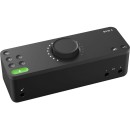
Audient EVO 8 |
VS | |||||
|---|---|---|---|---|---|---|
| Analog: 4 Inputs / 4 Outputs at 96 kHz |
Channels of I/O |
Analog: 2 Inputs / 6 Outputs at 96 kHz Digital: 8 Input / 0 Output at 48 kHz |
Analog: 4 Inputs / 4 Outputs |
Analog: 4 Inputs / 8 Outputs at 96 kHz ADAT: 16 Inputs / 16 Outputs at 48 kHz S/PDIF: 2 Inputs / 2 Outputs |
Analog: 2 Inputs / 2 Outputs at 96 kHz |
24 Inputs / 24 Outputs |
| 96 kHz / 24-Bit | Maximum Sampling Rate | 96 kHz / 24-Bit | 192 kHz / 24-Bit | 96 kHz / 24-Bit | 96 kHz / 24-Bit | 96 kHz / 24-Bit |
| 4 Preamps | Number of Microphone Inputs | 2 Preamps | 2 Preamps | 4 Preamps | 2 Preamps | 8 Preamps |
| 4x Combo XLR-1/4" TRS Balanced Mic/Line Input (Pin 2 Hot) 1x 1/4" TS Unbalanced Hi-Z Input (Front Panel) 4x 1/4" TRS Balanced Line Output (Tip Hot) 2x 1/4" TRS Unbalanced Headphone Output |
Analog Audio I/O |
2x Combo XLR-1/4" TRS Balanced Mic/Line Input 1x 1/4" TRS Unbalanced Hi-Z Input (Front Panel) 4x 1/4" TRS Balanced Line/Monitor Output 1x 1/4" TRS Unbalanced Headphone Output (Front Panel) 1x 1/8" / 3.5 mm TRS Unbalanced Headphone Output (Front Panel) |
2x Combo XLR-1/4" TRS Balanced/Unbalanced Mic/Line/Hi-Z Input 2x 1/4" TRS Balanced Line Input 1x 1/4" TRS Unbalanced Headphone Output 4x 1/4" TRS Balanced Line Output (DC-Coupled) 4x RCA TS Unbalanced Line Output |
4x Combo XLR-1/4" TRS Balanced Mic/Line Input 2x 1/4" TS Unbalanced Hi-Z Input 4x 1/4" TRS Balanced Line Output 2x 1/4" TRS Unbalanced Headphone Output 1x 1/8" / 3.5 mm TRS Unbalanced Headphone Output 2x 1/4" TRS Balanced Insert Send 2x 1/4" TRS Balanced Insert Return |
2x Combo XLR-1/4" TRS Balanced Mic/Line Input 1x 1/4" TS Unbalanced Hi-Z Input 2x 1/4" TRS Balanced Monitor Output 1x 1/4" TRS Unbalanced Headphone Output |
2x Combo XLR-1/4" TRS Balanced/Unbalanced Mic/Line/Hi-Z Input (Front Panel) 6x Combo XLR-1/4" TRS Balanced Mic/Line Input 8x 1/4" TRS Balanced Line Output 2x 1/4" TRS Unbalanced Headphone Output |
| 1x USB-C | Host Connection | 1x USB-C | 1x USB-C | 1x USB-C | 1x USB-C | 1x USB-C |
| macOS 10.7.5 or Later Windows 7 or Later (32-/64-Bit) |
OS Compatibility |
macOS 10.11.6 or Later macOS 11.1 or Later Windows 7 or Later |
macOS 10.11 or Later Windows 7 or Later 9 or Later |
macOS 10.11.6 or Later Windows 8 or Later (32-/64-Bit) |
macOS 10.7.5 or Later Windows 7 or Later (32-/64-Bit) 6 or Later |
macOS Windows |
| USB Bus Power | Power Requirements | USB Bus Power | USB Bus Power | AC/DC Power Adapter (Included) | USB Bus Power | AC Input |
